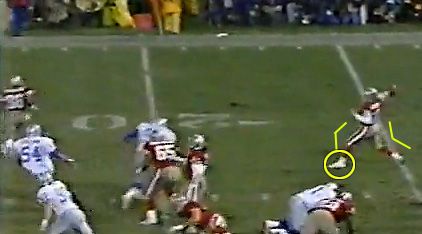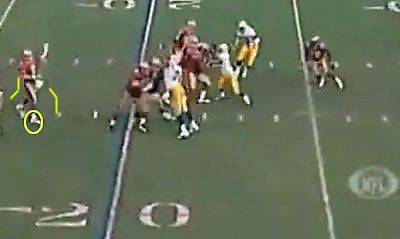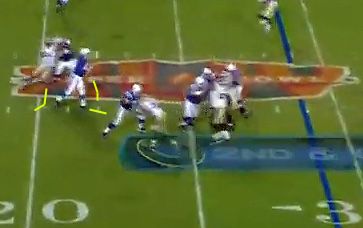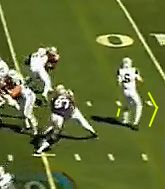“Watch his feet!” – Paul Maguire during his broadcasting career on NFL Sunday Night Football
Everybody knows the hallmark of a quarterback is their ability to deliver the ball down the field with their arm. Everybody also knows that coming out of college, one of the most common knocks against quarterbacks as rookies is their lack of footwork or lack of consistent footwork. Usually this problem can be corrected and result in a good quarterback becoming a stellar quarterback and in other cases, the quarterback in question simply never learns or develops those fundamentals and becomes a perennial underachiever.
There is a lot that goes into footwork, more so than just being able to drop back 3, 5, or 7 steps for timing to get the ball out of the hand. More goes into it as well than just rolling out on a designed play to the left or right of the field.
Let us start at the end of the drop. I can already see several of you wondering why I am going to the finish rather than the start. The finish is, in some ways, the most important aspect of a quarterbacks feet because it impacts their accuracy and the ability to drive or throw the ball far.
One of the absolute best in terms of footwork was Joe Montana, for both the San Francisco 49ers and later the Kansas City Chiefs in the twilight of his career.
In the below image taken from 1992, take note of several factors. The first focus should be on the front feet. Take note of the foot’s placement and direction, indicating precisely where Montana is aiming to throw. Lots of quarterbacks, especially younger ones, struggle to aim the lead foot towards their respective receiver which causes throws to be inside or outside of the spot where they are throwing. The other thing to notice is the knee bend of both the front and back knees. This allows Montana the hip torque required in his throwing motion to air the ball deep (or provide more strength/speed on intermediate throws).

Another quarterback well known for his accuracy was Steve Young, who would follow Montana in San Francisco under both Bill Walsh and then George Seifert. From the 1998 playoffs against Green Bay, note the similarities in footwork between the Montana image above and the Young image below at the time of their release. Young’s lead foot is aimed towards his intended receiver and both knees are bent to allow a good follow through of the hips. A lot of the quarterback’s arm strength and power comes from hip swivel.

Peyton Manning is considered a surefire Hall of Famer and near universally the best quarterback to ever play the game. In the below image, Manning relies more on his back leg to help torque the ball but maintains toe direction on the forward foot for accuracy.

Although most quarterbacks are now taking the snap out of the shotgun, the NFL in particular, still uses many pro style formations and requires dropping back from under center. Even quarterbacks like Robert Griffin III and Cam Newton, who primarily played shotgun in college, have had to adapt their styles to be able to drop back.
As you can see from the image below, Tom Brady (and most great dropback quarterbacks) have not only a quick first step but also a long stride to separate themselves from the center. This allows them to not get their feet tangled up by the center or guard but also allows them to get back from pressure quickly.

Here is a shot of Brady at the top of a 5 step drop. Notice that both feet, especially the plant back leg, are firmly planted in the ground and ready to push to allow Brady to climb up into the pocket or step into his throw immediately. Now he can hitch up a step and throw if its a timed play or hitch up and then roll out if he senses pressure.

Being able to cross the legs is equally important. Below is a picture perfect (pardon the pun) example of Dan Marino dropping back in 1984. Note the pushing off of the back leg and the planting of the lead leg that will allow him to push back further and faster as he maintains his drop.

A lot of the struggles for young quarterbacks is about foot placement. Often times, their foot placement in the pocket and in particular, directly after the top of their drop is the issue. This usually results in inaccuracy or an inability to properly climb and step into their throw downfield.
One example of this is Mark Sanchez, seen in his rookie season in 2009. Note that this is his hitch step up directly after reaching the top of his drop (as shown in the Brady image above). His feet are incredibly close to one another, less than half a yard and as a result of his knee bend and feet aim, he does not have the proper open hips to allow him to accurately throw if he were pressured at that moment. As he steps up, his feet are still firmly facing the sidelines leaving his arm and hip rotation to also ‘follow’ where his feet are aiming.

What made Robert Griffin III and Russel Wilson stand out was their excellent footwork, especially as rookies. In the image below, take note of Griffin at the top of his drop. Nearly mirrors how Brady looked in his drop. He has enough push to hitch up and space to step up into his throw, greatly aided by how he is already in great position with his feet.

So when looking at this year’s group of rookie quarterbacks or trying to ascertain who the next successful young thrower will be, as one Paul Maguire might say, “Watch the feet!”
Credit to Colorado’s 9News.com for feature image

